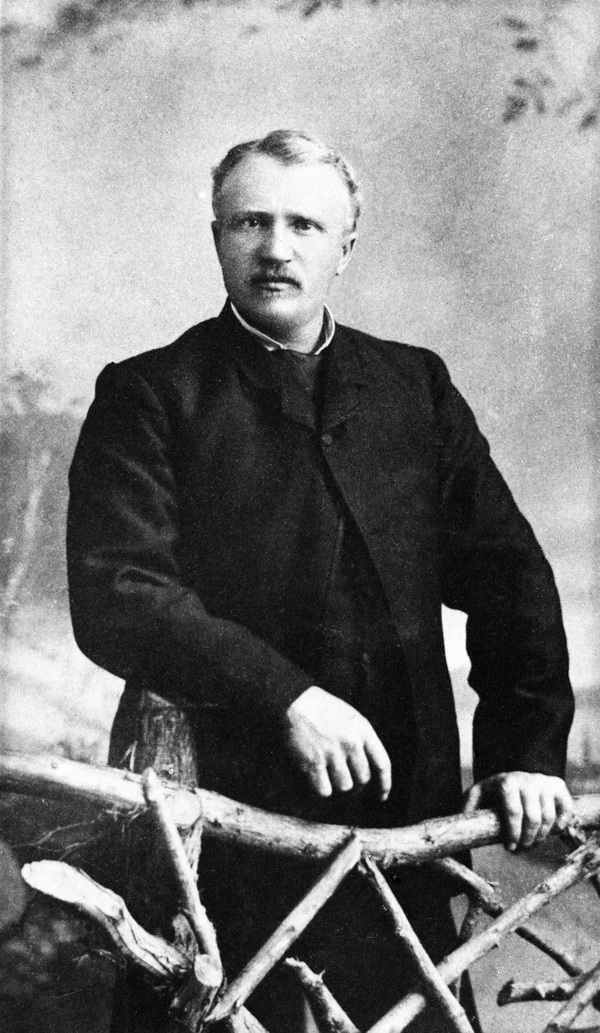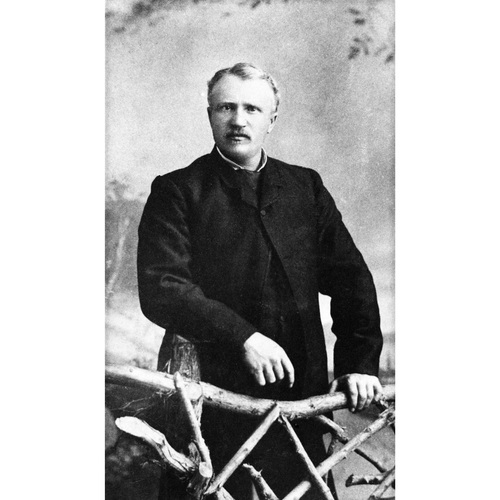
Source: Link
LUCAS, SAMUEL BRIGHAM, Indian agent; b. 15 July 1844 in Aylmer, Lower Canada; m. 4 May 1871 Amelia Frances Aylwin, and they had one daughter and two sons; d. 13 Feb. 1907 in Ponoka, Alta.
Samuel Lucas became a surveyor in his youth and practised that trade in his native Ottawa valley until an opportunity arose to enter the federal service in 1879. In that year the government of Sir John A. Macdonald* embarked on a scheme to avert mass starvation among the Indians of the North-West Territories and ward off the danger of violence from them. It involved appointing farm instructors whose immediate task was to raise enough food for native needs and whose long-term goal was to teach the former buffalo-hunters the techniques of tillage and herding. Lucas was one of those hired and he arrived in the west during the autumn of 1879 to take up his posting in the Edmonton Indian agency. The Cree bands of chiefs Kiskaquin (Bobtail), Ermineskin, and Samson and the Stoney of Chief Sharphead were under his charge.
For the first few years Lucas developed his supply farm and encouraged the Indians to make a start in agriculture. Progress was slow, in part because of the government’s failure to provide the equipment promised in treaties. In December 1884 the Department of Indian Affairs reorganized its administrative structure in the northwest and Lucas, although in charge of the same bands, was elevated to the position of agent in the newly created Peace Hills agency. When news of the North-West rebellion [see Mistahimaskwa*] reached the agency in the spring of 1885, he moved with his family to the safety of Edmonton. The chiefs at Peace Hills remained loyal, but there was some looting and a number of young men went off to join the fight.
His superiors considered Lucas an effective agent who possessed “a happy knack of managing his Indians.” His record-keeping was, however, unsatisfactory and a clerk was hired to look after his office. The agent spent a good part of his time among the Indians directly supervising their work. There was much to be done – breaking soil, planting, harvesting, building houses and fences, and cutting wood. Those who worked hard were rewarded with rations of flour and bacon at the end of the week; those who refused to work received none. It was a harsh system and Lucas implemented it conscientiously. Even so, he retained the respect of the Indians.
Lucas was an Anglican and, although he took his religion seriously enough, he was certainly no fanatic. Because of his easy tolerance, he ran foul of the missionaries who laboured in the agency, and in the case of the Methodist teacher, the Reverend John Nelson, bitter enmity arose. Matters came to a head between the two men in 1889 when Nelson made a formal complaint against Lucas to the Department of Indian Affairs. He alleged that the agent had neglected the Stoney during the harsh winter of 1886–87 when many of them had died, and that he was “excessively intemperate,” a “habitual sabbath breaker,” and prone to use language that was “most shamefully vile, profane and obscene.” So serious were these charges that the department sent one of its agency inspectors, Alexander McGibbon, to investigate. McGibbon made a thorough inspection of the Peace Hills operation and was impressed by the numerous indications of orderliness and progress that were to be seen. He interviewed Indians of all bands in the agency and noted the warm terms in which they spoke of their agent. He cross-examined witnesses brought forward by both Lucas and Nelson and concluded that the charges were grossly exaggerated.
Upon receiving McGibbon’s report the Indian department agreed that Lucas could keep his job but warned him to be more careful in his use of alcohol. The agent had apparently been in the habit of carrying a flask of whisky in his pocket while on the job, a practice strongly disapproved of. But officials in the Methodist Church were not prepared to let the matter rest. They wanted an agent who would give a better moral example to the Indians they were attempting to evangelize. They approached their political friends who threatened to raise the issue in parliament. The superintendent general of Indian affairs, Edgar Dewdney*, wished to avoid complications and passed the word that changes should be made at Peace Hills. In May 1890 Lucas was informed that he was being transferred to the Sarcee agency just outside Calgary. It was a bitter blow – it would mean a loss of reputation since the slanders directed against him would now be believed. Besides, he had come to regard the Peace Hills district as home and was loath to leave. He appealed the decision but in vain.
In April 1891 Lucas moved with his family to Sarcee. There he carried on with the familiar work of encouraging the Indians to make the adjustment to settled life. In the semi-arid climate of what is now southern Alberta, the Indian department laid great store by cattle-raising, and one of Lucas’s principal aims became to increase the band’s herds. He was never happy at Sarcee, however, and in 1897, at the comparatively young age of 53, he retired from the federal service. He then returned to his old haunts, settling on a homestead four miles east of Siding 14 (Ponoka). There he worked the land and did some surveying for other settlers until his sudden death on 13 Feb. 1907.
During his career as an Indian agent, Samuel Lucas had remained loyal to the aims of his department and struggled diligently to make its difficult policy function. He could be tough when the occasion warranted, but he was not unbending, even though evidence of generosity invariably brought a reprimand from his superiors. His “colourful” language and fondness for drink never impaired his ability to get the work done. Indeed he was more competent and more honest than most of the Indian agents in the northwest at the time.
There is a photograph of Samuel Brigham Lucas in the GA.
GA, M699; M4051. NA, MG 29, E106, 18; RG 10, 3575, 3600, 3640, 3685, 3697, 3700, 3718, 3746, 3762, 3772, 3785–86, 3809, 3843. Can., Parl., Sessional papers, annual reports of the Dept. of Indian Affairs, 1879–97. [E.] B. Titley, “Transition to settlement: the Peace Hills Indian agency, 1884–1890,” Canadian papers in rural history, ed. D. H. Akenson (8v. to date, Gananoque, Ont., 1978– ), 8: 175–94.
Cite This Article
E. Brian Titley, “LUCAS, SAMUEL BRIGHAM,” in Dictionary of Canadian Biography, vol. 13, University of Toronto/Université Laval, 2003–, accessed January 4, 2026, https://www.biographi.ca/en/bio/lucas_samuel_brigham_13E.html.
The citation above shows the format for footnotes and endnotes according to the Chicago manual of style (16th edition). Information to be used in other citation formats:
| Permalink: | https://www.biographi.ca/en/bio/lucas_samuel_brigham_13E.html |
| Author of Article: | E. Brian Titley |
| Title of Article: | LUCAS, SAMUEL BRIGHAM |
| Publication Name: | Dictionary of Canadian Biography, vol. 13 |
| Publisher: | University of Toronto/Université Laval |
| Year of publication: | 1994 |
| Year of revision: | 1994 |
| Access Date: | January 4, 2026 |



